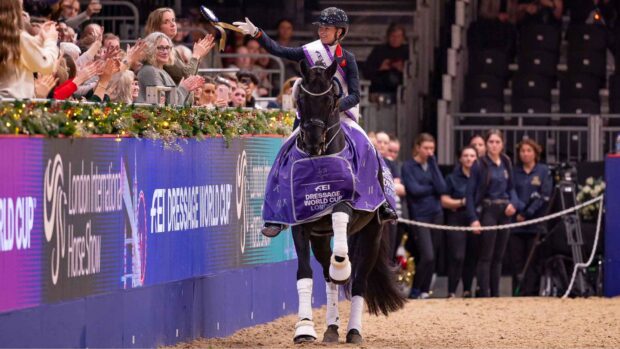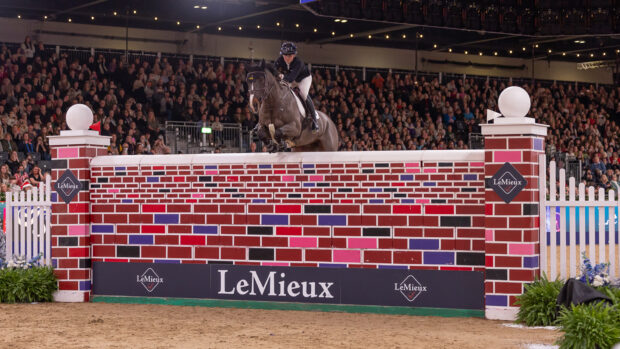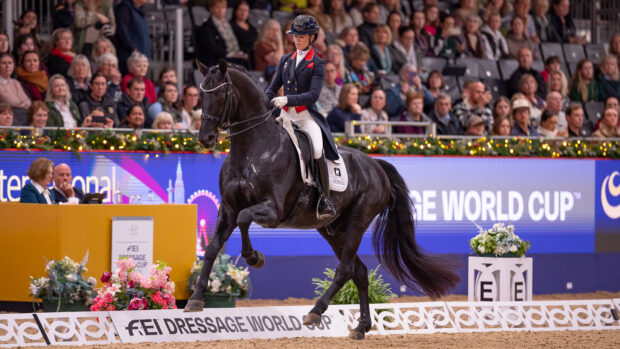Dressage horses competing at the top of the sport were more likely to be marked higher if they were behind the vertical, a study has found, which “implies that there might be concerns related to animal welfare and rule compliance”.
Kathrin Kienapfel, of the equine research group at the Swiss national stud, led the investigation, published in Applied Animal Behaviour Science. It considered head-neck positions (HNPs) and “conflict behaviour” in horses competing in the grand prix special at a five-star international competition in 2018 and 2019.
The team analysed the angles of the poll, nasal plane and shoulders, and any conflict behaviour, in the form of tail-swishing or “unusual oral behaviour”, in the warm-up and in the arena.
“Horses with noselines held further behind the vertical tended to receive higher scores,” the study’s conclusion states.
“The result implies that there might be concerns related to animal welfare and rule compliance. The observed HNPs used by world-class riders in this study appear to contradict the established rules, yet these deviations are not penalised by the judges during competitions.”
Dr Kienapfel told H&H: “I think this points to the need for change. If we look at the median values, we can see that most of the horses are ridden, especially in the warm-up, with their nose line behind the vertical. And the horses show a high amount of conflict behaviour; I didn’t expect to see that much.”
The study notes that by FEI guidance at the time, horses’ heads should not have been behind the vertical. It found that horses were behind the vertical more often and showed more conflict behaviour in the warm-up than in the arena.
“It’s obvious to me as a lover of classical dressage that the rules are not always adhered to,” Dr Kienapfel said. “The rules cite the horse as a happy athlete as the main thing and that horse welfare is paramount.”
Dr Kienapfel said she wanted to investigate how top-level horses feel while being ridden, as they are “the mirror of horse sport, which everyone looks at”. The aim of the study was to provide an objective view, with clear parameters, so whoever assessed the horses, the results would be the same.
“For me, the results are surprising,” she said.
Dr Kienapfel noted that there are many factors behind horses’ scores and the HNP is just one of these.
“But if you don’t make mistakes and your horse’s poll is tight, it’s not necessarily sanctioned,” she said. “If you do a good performance and your horse is behind the vertical, you’ve got a good chance of doing well.
“I don’t know why there’s such a problem acknowledging that there is a problem. We should have acted yesterday but if we don’t, in the near future, riding horses will be forbidden, for welfare reasons. I strongly believe it is possible to ride, and do dressage, as a harmonious partnership.”
FEI dressage judge Stephen Clarke told H&H it is stewards’, not judges’, role to be aware of what is happening in the warm-up area.
“We have excellent stewards who ensure that the horses are not ridden in an abusive or excessively overbent position for any length of time in the warm -up areas,” he said.
“The judge’s role is to assess how close the horse conforms to the ideal criteria of the ‘training scale’ and must be prepared to use the scale of marks from 0 to 10 depending on the performance of each and every movement. For the 10 to be awarded, all criteria must be fulfilled to their utmost.”
But, Mr Clarke said, it is the overall picture that must be evaluated.
“We do see horses with great impulsion and expression, fulfilling the majority of the ideals of the training scale, but maybe a fraction behind the vertical, or maybe a little low at the poll,” he said. “They can still be awarded fairly good scores, but the 10s will evade them.
“We can also have horses that may appear to be in a ‘correct position’ with the head and neck, but appear stiff in the back, lacking suppleness, impulsion and elasticity within their way of going, with dull and lifeless paces. These horses cannot be awarded anything above satisfactory; six at best.
“We sometimes see the other extreme, where the horses are obviously stressed, eyes popping, chins almost on their chests, with an exaggerated expression within their paces which comes only from tension, rather than from true impulsion. These situations must be scored harshly.
“We, as judges, must recognise correct training, and reward true impulsion and harmony which produces the true expression that our onlookers can appreciate.”
An FEI spokesman told H&H the FEI had received the study.
“It will be thoroughly reviewed and discussed during the upcoming FEI veterinary committee meeting on 3 and 4 April, alongside other pertinent scientific articles recently published,” he said.
You might also be interested in:

Study shows horses learn better when they are more relaxed

Scientists aim to identify ‘spooky’ genes in new equine research

Young dressage horse classes: ‘I don’t want to see them looking like mini grand prix horses’
Paul Hayler, Paul Fielder and Isobel Wessels reveal what they are looking for in future grand prix dressage horses

Subscribe to Horse & Hound magazine today – and enjoy unlimited website access all year round
Horse & Hound magazine, out every Thursday, is packed with all the latest news and reports, as well as interviews, specials, nostalgia, vet and training advice. Find how you can enjoy the magazine delivered to your door every week, plus options to upgrade your subscription to access our online service that brings you breaking news and reports as well as other benefits.




